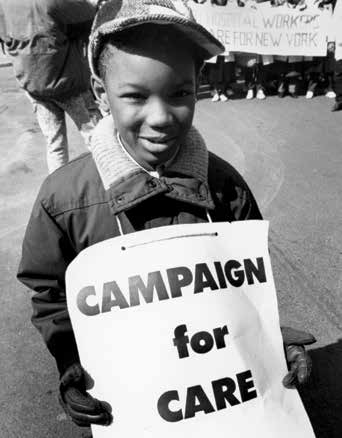HOW 1199 HAS WON LANDMARK CONTRACTS
April 30, 2023
Member mobilization was the key ingredient.

The wage increases that were agreed at the recent League wage re-opener in early March, is just the most recent win. Central to these victories was broad community support, political action, expert public relations and communications. Most important, was the work of members in the workplace.
But the sizable increases League members just negotiated would not have been possible without Governor Nelson Rockefeller’s 1963 signing of state legislation extending collective bargaining rights to New York City’s hospital workers. During that campaign, Governor Rockefeller received a call from Dr. Martin Luther King, Jr. urging him to sign the bill.
Dr. King’s call reflected 1199’s ability to frame the economic struggle as a civil rights issue.
The campaign for workers’ rights and quality care was championed in New York’s communities of color. For example, the Spanishlanguage daily, El Diaro, dubbed the hospital campaign, “La Cruzada” (“The Crusade”).

A changing industry environment of cost-cutting and consolidation meant that in 1972 and 1974, the Union won most of its demands through arbitration. A disappointing award in 1976 prompted President Leon Davis to declare, “We have been deceived.
. . . the results this time will correspond to our strength; and our strength will correspond to our unity.”
That unity led to a 1980 contract providing a 14.5 percent increase over two years. Internal conflicts within the Union resulted in an ill-fated 46-day strike and subpar contract in 1984.
When the reformist Save Our Union slate regained leadership in 1986, the tide began to turn.
A central element of that change was reconstituting the delegate structure and rebuilding unity.
The 1989 contract brought raises of 24.6 percent over four years and significantly improved benefits.
“The Union isn’t distant anymore,” Mount Sinai clerk Rosemarie Marrith said at the time. That contract campaign also highlighted the plight of newly-organized home care members.
In the 1990s, the Union had to turn its focus more directly on Albany and Medicaid reimbursement rates. Countless demonstrations by 1199 and its allies across the state and in the state capital prevented proposed Medicaid cuts of more than $11 billion during the decade.
Aware that its resources were inadequate to meet the growing challenges of deregulation, restructuring and mergers within the healthcare industry, 1199’s members voted in 1998 to merge with SEIU, the largest healthcare union in the nation. That, along with other mergers, expanded the Union’s strength and reach.
1199 faced another challenge after the September 11, 2001 terrorist attacks and the subsequent economic decline.
Union members and the League voted to extend the existing contract. Months later, in spite of the economic environment, the Union reached a groundbreaking agreement with the League. But the agreement depended on $2 billion in state funding. Members of the state legislature wavered, but agreed on the funding after intense lobbying and the sight of several thousand chanting members who descended on Albany.
The environment was also decidedly grim in 2008, with the nation facing its deepest economic downturn since the Great Depression of the 1930s.
The crisis was so serious that in order to save the pension fund, the Union and the League agreed to reopen the contract two years before it was scheduled to expire.
Members made some concessions on scheduled wage increases, but their world-class benefits remained intact.
Nicholas Denesopolis, lead receiving clerk at Lenox Hill Hospital in Manhattan, summed up the sentiments of many 1199ers at the time. “I came to 1199 because of the benefits and pension,” he said. “I just want some security. We got it.”
Elizabeth Akong, an RN at Jamaica Hospital in Queens, said, “We were able to win this contract because we kept our members informed and involved.”
1199 Magazine: March / April 2023

